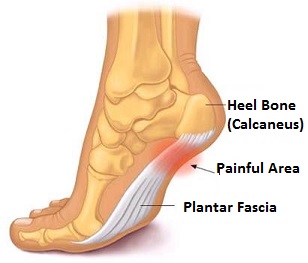
• Dull, intermittent pain. May progress to a sharp, but sustained knife-like pain
• Pain is typically worse immediately after getting out of bed, after sitting, when climbing stairs or after intense activity. Usually eases off throughout the day, but returns after intense or increased physical activity or prolonged weight-bearing
• Pain can be sufficient to cause sufferer to limp with heel lifted off the ground. In the long-term, this can worsen the problem by affecting gait
The mechanics of walkingAfter the heel makes contact with the ground, the tibia turns inward and the foot pronates (rolls inward), stretching the plantar fascia and flattening the arch to accommodate irregularities in the walking surface. |
Tension in the plantar fasciitis is critical to maintaining foot arch and serves as a shock absorber for foot and leg
With aggravating factors, repetitive movements (E.g. walking / running) cause multiple micro-tears in the plantar fascia, weakening the foot arch. This further increases strain on the plantar fascia
Possible Causes / Aggravating Factors
Plantar fasciitis typically occurs only in one foot
Plantar fasciitis can dramatically affect physical mobility and also lead to heel spurs. Microscopic tearing of plantar fascia can cause inflammation of the heel bone (calcaneus) leading to the production of bone growths (spurs), which may or may not be painful
Plantar fasciitis is the most common cause of heel pain
• An estimated 10% of U.S. population will experience plantar heel pain in their lifetime
Crawford F, Atkins D, Edwards J. Interventions for treating plantar heel pain. Cochrane Database Syst Rev 2000;(3):CD000416. Update in: Cochrane Database Syst Rev 2003;(3):CD000416.
• Accounts for 11-15 % of all foot symptoms
Pfeffer G, Bacchetti P, Deland J, et al. Comparison of custom and prefabricated orthoses in the initial treatment of proximal plantar fasciitis. Foot Ankle Int 1999;20:214-221.
• 2 million people in the U.S. are treated for plantar fasciitis on an annual basis